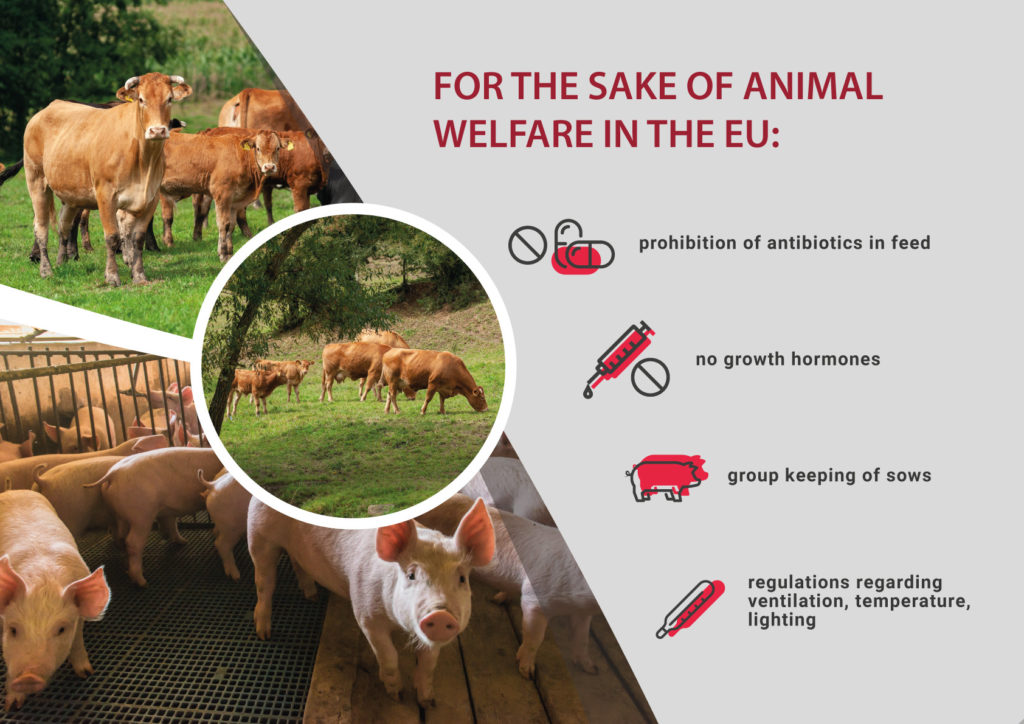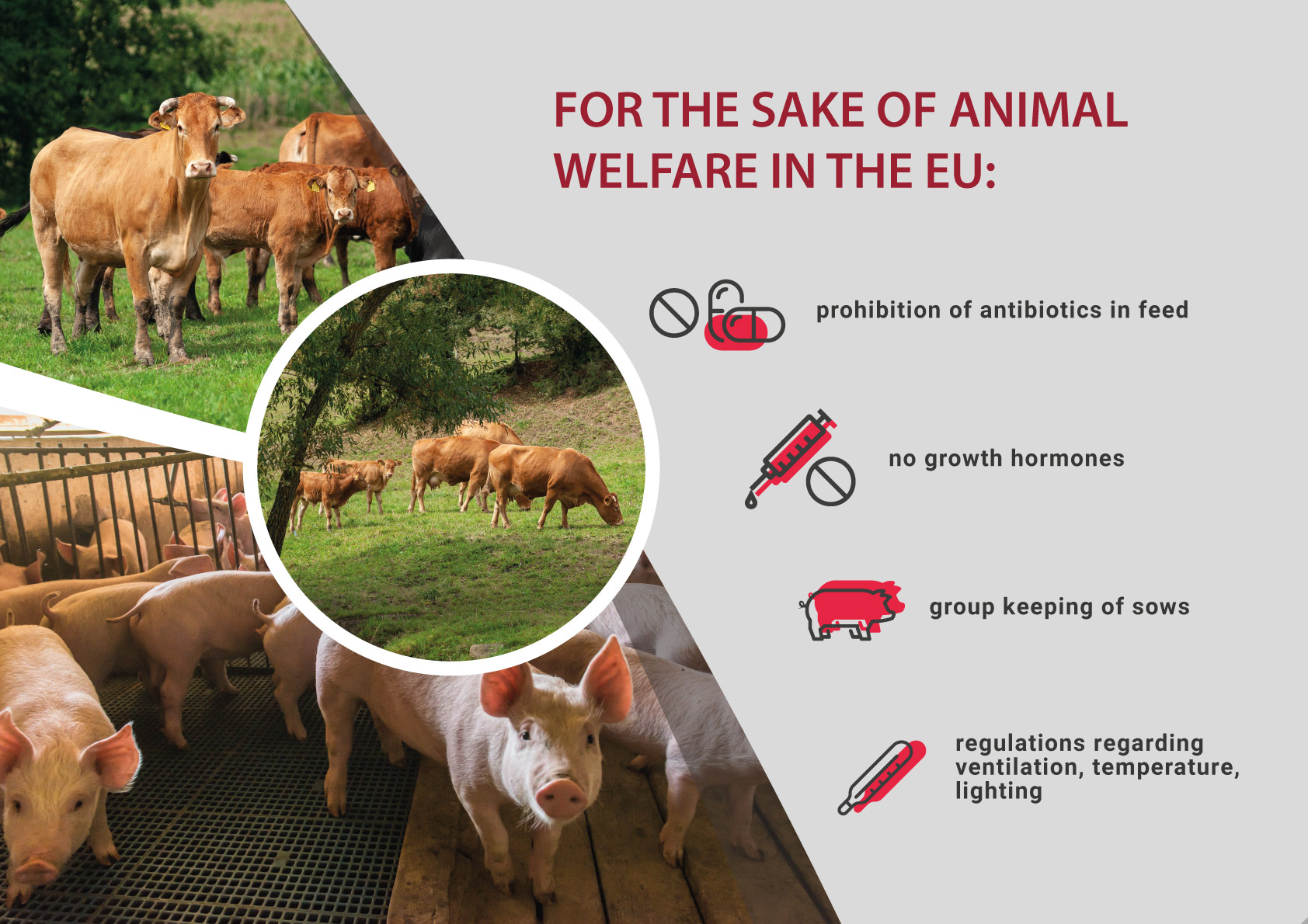Nowadays, animal welfare is a frequent topic in the public debate. Aware consumers demand products that are produced in an ethical manner, with maximum respect for animal rights. It is worth knowing, however, that this issue was already embedded in the foundations of the operation of the European economic community several decades ago, and that animal rights in Europe have been respected for several hundred years.
Of all the corners of the globe, it is in Europe that animal protection laws are the most complex and enjoy a lot of attention. Europeans, who at the beginning of the nineteenth century began the development of modern animal welfare requirements, have consistently remained their advocates for the next two hundred years. Over time, other countries such as the USA, following the example of the old continent, have introduced regulations on animal production, but it is still Europeans who set the global trends in this area.
The current legislation on animal welfare dates back to the times of the European Coal and Steel Community, when in 1974 the document now called the Thirteenth Article on the Functioning of the European Union created the basis for establishing Community law in the area of agricultural, environmental and animal[1] welfare policy. But animal rights have a much longer tradition in Europe.
Historically, the first person to address the subject of animal rights was Pythagoras in ancient Greece[2]. He proclaimed the need to treat animals humanely, but this view remained within the area of philosophical discussions. Europeans have also been pioneers in creating animal rights legislation. The Irish Parliament in 1635 passed “An Act against Plowing by the Tayle, and pulling the Wooll off living Sheep”, the first animal rights document in the world to protect sheep and horses from mistreatment[3].
The passed law started intensive philosophical discussion and led to the emergence of new regulations on animal protection. New laws were introduced in Europe to protect horses, sheep, cattle and later pigs. An important event was introduction of the concept of the “five freedoms” into UK legislation in 1965, which guaranteed freedom of movement for farm animals and appropriate welfare to ensure their adequate comfort[4]. The European Union was the first entity to introduce international regulations on livestock.
In 1974, a Directive introducing a requirement for stunning animals before slaughter was adopted, applicable in each of the EU member states[5]. Subsequently, in 1976, the European Convention for the Protection of Animals Kept[6] for Farming Purposes was introduced, which guaranteed that the right conditions were met to satisfy the physiological needs of animals in terms of temperature, light and available space, so that they could be kept in conditions as close as possible to natural ones. This legislation also covered the transport and slaughter of animals. It is worth noting that to date the USA has not introduced a similar convention[7].

With the development of the European Union, minimum welfare standards were introduced in 1993 for most European[8] livestock species. The introduction of the Directive on the general welfare of all farmed animals, including fish[9] in 1998 was a revolution. The Directive introduced a direct requirement to guarantee five freedoms to animals:
- freedom from hunger and thirst,
- freedom from discomfort,
- freedom from pain and disease,
- freedom to express normal behaviour,
- freedom from fear and distress[10].
But animal welfare requirements are not a history, but a constantly evolving area of law in the European Union. Since the 1990s, many solutions have been introduced that are still rare in the world: the ban on antibiotics in feed (2003)[11], the ban on the use of growth hormones (1996)[12] and the requirement for group housing of sows (2008)[13]. There is also a number of specific requirements concerning ventilation, environmental conditions, lighting and stocking density, which could serve as examples for other countries. It seems that in the near future the EU will continue to be a pioneer in the scope of animal welfare development, continuing the centuries-long tradition.
- [1] http://www.fondation-droit-animal.org/proceedings-aw/the-european-union-legislation-on-animal-welfare/
- [2] https://www.businessinsider.com/the-story-of-one-of-the-worlds-first-modern-vegetarians-2016-3?IR=T
- [3] https://en.wikipedia.org/wiki/An_Act_against_Plowing_by_the_Tayle,_and_pulling_the_Wooll_off_living_Sheep
- [4] https://www.animallaw.info/article/detailed-discussion-european-animal-welfare-laws-2003-present-explaining-downturn
- [5] https://www.animallaw.info/article/detailed-discussion-european-animal-welfare-laws-2003-present-explaining-downturn
- [6] https://www.coe.int/en/web/conventions/full-list/-/conventions/treaty/087
- [7] Darian M. Ibrahim, The Anticruelty Statute: A Study in Animal Welfare , 1 Journal of Animal Law and Ethics 176 (May 2006)
- [8] https://eur-lex.europa.eu/legal-content/EN/ALL/?uri=CELEX%3A31993L0119
- [9] https://eur-lex.europa.eu/legal-content/EN/TXT/?uri=celex%3A31998L0058
- [10] http://www.fondation-droit-animal.org/proceedings-aw/legal-standards-and-animal-welfare-in-european-countries/
- [11] Regulation (EC) No 1831/2003 of the European Parliament and of the Council of 22 September 2003 on additives for use in animal nutrition
- [12] Council Directive 96/22/EC
- [13] Council of Europe Directive 2008/120/EC
